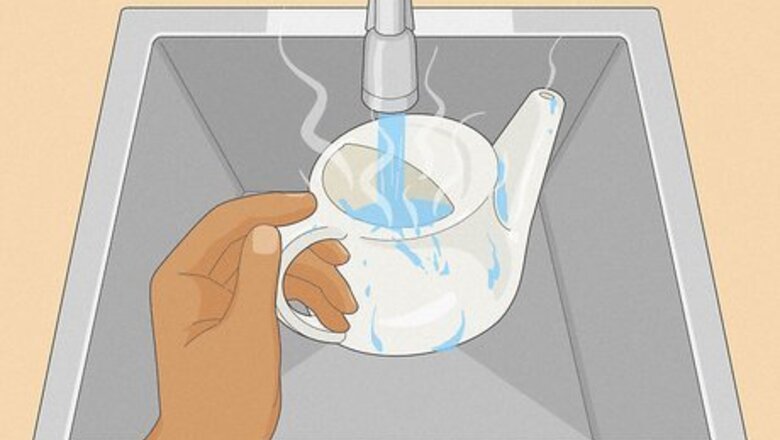
views
- Rinse the inside of the pot, spout, and lid with hot water. Then, fill the pot with hot distilled, filtered, or previously boiled water and several drops of dish soap.
- Shake the neti pot vigorously to agitate the soapy water and scrub the pot with a bottle brush. Then, rinse the pot with sterile water and let it air dry.
- Wash your neti pot after each use. If you use a plastic neti pot, replace it every 3 months.
Sanitizing a Neti Pot with Dish Soap
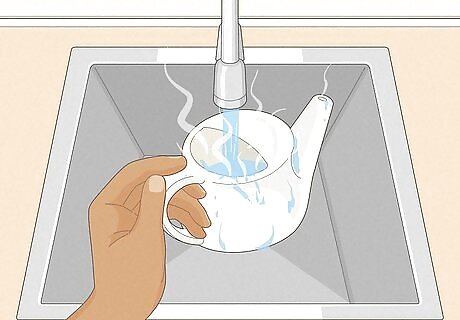
Rinse the cap, pot, and spout with hot water. Run a stream of hot water directly into the pot, swirling the water around to rinse the interior. Hold the cap under the water to rinse it off, too. Then, pour out the water through the spout. This helps flush out bacteria and traces of the saline solution. A preliminary rinse helps to wash away most unwanted contaminants in your neti pot. Always rinse and wash your pot after using it. Don't neglect cleaning the lid of the pot. While it doesn't come into direct contact with your nose, bacteria can infiltrate the lid and contaminate the pot.
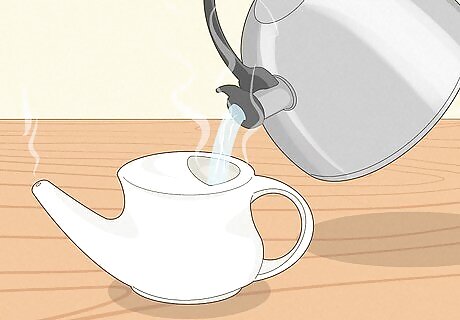
Fill the pot with hot distilled or filtered water, or previously boiled water. Regular tap water can contain bacteria and amoebas that are harmful when flushed through your sinuses. So, fill your neti pot with bottled distilled water or filtered water that’s been passed through a pore size of at least 1 micron. Or, boil tap water for at least 3 to 5 minutes and let it cool slightly. Check your neti pot’s instructions to learn what type of filtered water is recommended for use. Some manufacturers recommend using a 0.2 micron filter. Filters that are labeled “NSF 53” or “NSF 58” or read “cyst removal” or “cyst reduction” are safe to use. Do not use boiling water in the pot, as the heat can damage the device. Allow the boiled water to cool slightly before pouring it inside.
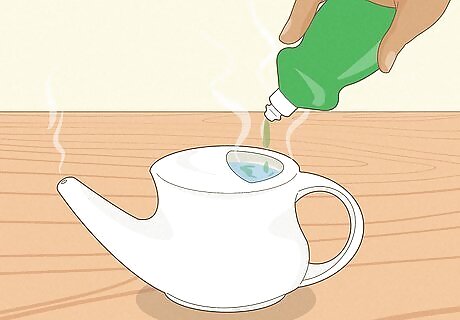
Add a few drops of dish soap to the water. It's recommended that you use a mild cleanser, like liquid dish detergent or antibacterial all-purpose soap, to sanitize a neti pot. Squeeze several drops of soap into the pot that’s filled with distilled, filtered, or previously boiled water. For best results, leave the soap solution to soak for a few minutes. Never use soaps containing harsh chemicals or astringent agents, like bleach. Besides being hazardous to put in your body, these compounds can damage the neti pot.
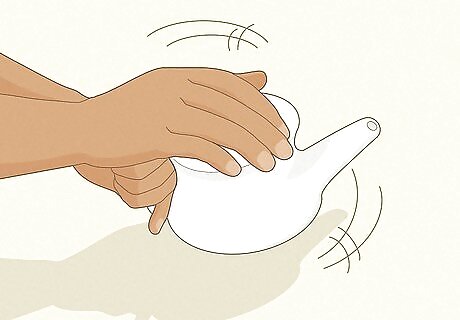
Shake the pot vigorously to mix the soap and water. Put the lid on the pot and hold your hand over the opening of the spout. Then, shake the neti pot for several seconds. This mixes up the soap solution and cleans the inside of the pot.
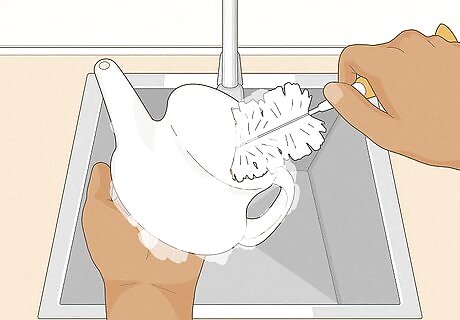
Scrub the pot, lid, and spout with a bottle brush. Use a clean (or recently sterilized) bottle brush to gently scrub inside the pot and the spout. Then, scrub the inside and outside of the lid. Finally, use the brush to clean the surface of the neti pot. Scrubbing the pot loosens any saline solution buildup while the soapy water cleans and disinfects any bacteria and other contaminants. To sterilize your cleaning brush, run it through the dishwasher. Or, soak the brush in 1 c (237 ml) of white vinegar and a drop of dish soap for 1 hour. Rotate the neti pot as you scrub to make hard-to-reach spots easier to access.
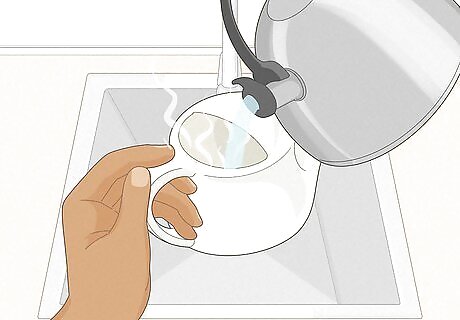
Rinse out the pot with distilled, filtered, or previously boiled water. Pour out the soapy water and flush the inside of the pot, the spout, and the lid with sterile water. Keep refilling and emptying the pot until the water is completely clear; there should be no soap solution remaining in the pot. Reminder: Do not use regular tap water to rinse out a neti pot. Tap water can contain potentially harmful bacteria and other contaminants. Make sure the pot, lid, and spout are completely free of soap. Leftover soap residue can irritate your sinuses.
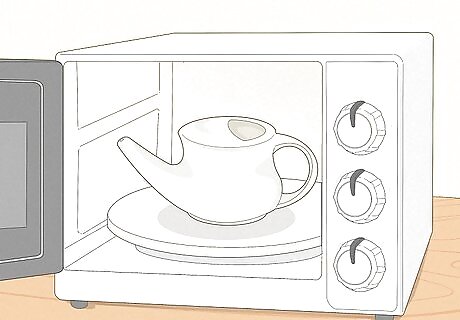
Microwave the pot for 40 seconds as an extra sanitization step. While optional, briefly heating your neti pot can help ensure no bacteria is left inside. Simply shake off excess water on the pot and lid and place them in your microwave. Then, heat the device for 40 seconds. If you recently used your microwave, let the inside cool down before microwaving the neti pot.
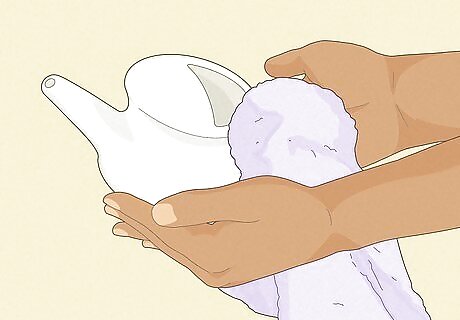
Let the neti pot completely air dry before using or storing. Shake the excess water from the pot and lid and place them upside down on a clean towel to finish draining and drying. When your neti pot is fully dry, use it again or store it in a clean, dry spot. Leave the lid off the pot to prevent moisture from getting trapped inside. Excess moisture can lead to mold and bacteria growth. Alternatively, dry your neti pot with a clean microfiber cloth or paper towel. Avoid towels made from cotton or similar fabrics—these can leave behind small fibers inside the pot.
Disinfecting a Neti Pot with Vinegar or Isopropyl Alcohol
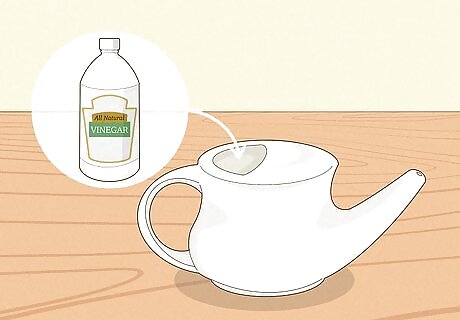
Rinse the inside of the pot with white vinegar or 70% isopropyl alcohol. White vinegar and isopropyl alcohol both disinfect your neti pot to remove bacteria and other contaminants inside. Simply fill the pot with either 1 part vinegar and 3 parts water or isopropyl alcohol. Swirl the solution inside the pot and then pour it out through the spout. Clean the lid with vinegar or isopropyl alcohol, too.
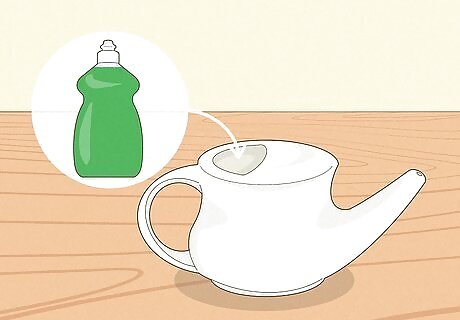
Wash the pot with hot distilled or filtered water and dish soap. Fill the neti pot with bottled distilled water or filtered water, or boiled water that’s cooled slightly. Then, add a few drops of dish soap, put on the lid, and shake the pot vigorously. To ensure the pot is completely clean, scrub the interior, spout, and lid with a bottle brush. If you’re boiling tap water, let it boil for 3 to 5 minutes to completely sterilize it.
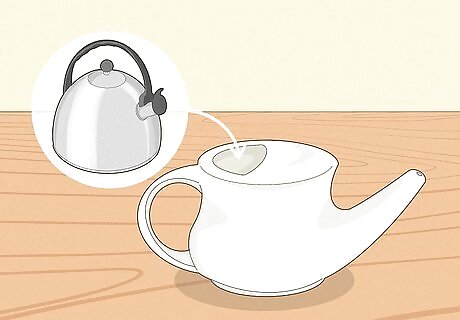
Rinse the pot with distilled or filtered water and let it air dry. Fill the neti pot with sterile water and pour it through the spout to get rid of the soapy water. Just repeatedly fill the pot and dump the water until the pot is free of soap residue. Then, place the pot and lid upside down on a clean towel to dry. Alternatively, use previously boiled water to rinse the pot. Make sure to rinse the lid with water, too.
Using Your Neti Pot Safely and Correctly
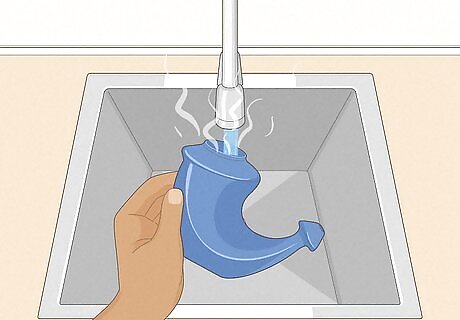
Wash your neti pot after every use. As soon as you’re done using your neti pot, clean it with distilled, filtered, or boiled water and dish soap. This prevents bacteria and other potentially harmful contaminants from getting into your sinuses. Cleaning also keeps your neti pot in good condition and ensures minerals don’t build up inside. Don't skimp on the cleaning process. A simple rinse isn’t enough to get rid of potentially harmful bacteria. Disinfecting your neti pot is key to practicing safe, responsible hygiene.
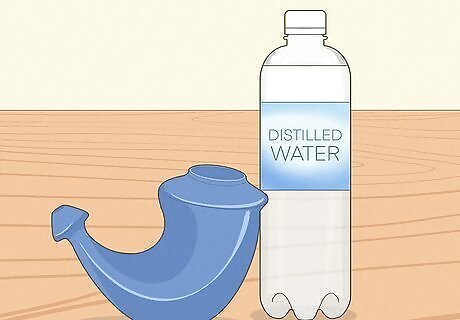
Use lukewarm distilled, filtered, or boiled water in the neti pot. When preparing your neti pot to irrigate your sinuses, make sure you fill it with bottled distilled water, water filtered through at least a 1-micron filter, or tap water you boiled for 3 to 5 minutes. Then, ensure the water is lukewarm or room temperature—hot and cold water can potentially harm your sinuses. Regular, unboiled tap water can contain bacteria, amoebas, and other contaminants that are harmful when introduced to your sinuses. If you're boiling tap water, let it cool down to room temperature before using it in the neti pot. Store any leftover boiled water in a clean container. It can keep for up to 1 day.

Rinse your sinuses with sterile water and a packaged saline solution. After filling the pot with sterile water, add a saline solution packet. Put on the lid and shake the pot to mix the solution. To use the neti pot, tilt your head sideways over the sink so your forehead and chin are about level. Place the spout of the pot inside your nostril that’s closest to the ceiling. While breathing through your mouth, lift the pot to dispense the solution through your nostril and sinuses. As you pour, the saline solution drains through your other nostril. Let the solution drip out of your nose and gently blow your nose to clear it. Then, repeat the process using your other nostril. Wash your hands thoroughly before using the neti pot. Alternatively, make your own saline solution. Mix 3 tsp (17 g) of iodine-free salt (pickling, canning, or kosher) with 1 tsp (6 g) of baking soda. Then, add 1 tsp of the mixture to 1 c (237 ml) of lukewarm, sterile water.
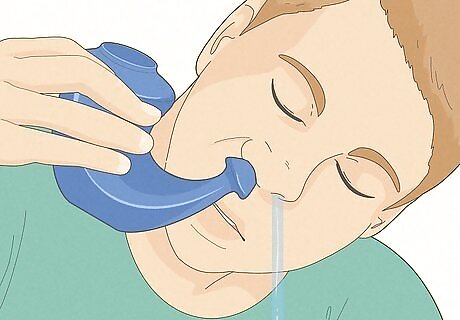
Use your neti pot 1 to 2 times each day. Irrigate your sinuses with the neti pot daily until you no longer have congestion-related symptoms. If the neti pot is really helping clear up your sinuses, use it 2 times each day. Stop using the neti pot and talk to your doctor if your symptoms don’t get better or get worse, or if you’re experiencing nose bleeds, headaches, or fever. Consult your doctor before using the neti pot on children. It is generally not recommended for use on children under 4 years old.
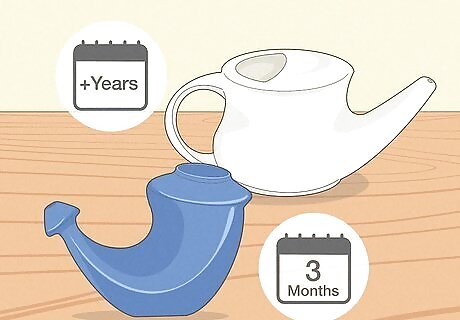
Replace plastic neti pots every 3 months. If you use a plastic neti pot, get a new one about every 3 months. Over time, bacteria, mineral deposits, and other contaminants can build up inside the pot, making it unsafe to use. Replace neti pots made out of any material (e.g., plastic, ceramic, glass) if you notice damage or discoloration even after cleaning them. Non-plastic neti pots typically last for several years with regular sanitization.
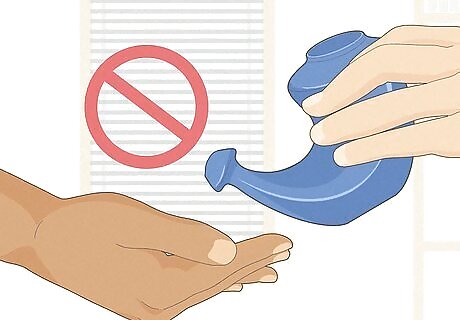
Don't share your neti pot with anyone else. Letting someone else use your neti pot increases the risk of transferring bacteria and other contaminants into your sinuses, even if you disinfect it between uses. Play it safe and make sure only you use your neti pot. Neti pots are like toothbrushes, loofahs, or retainers—everybody should have their own.


















Comments
0 comment